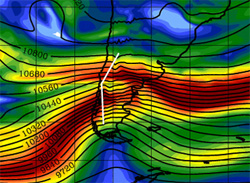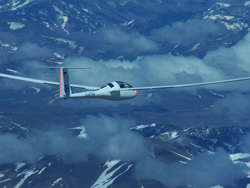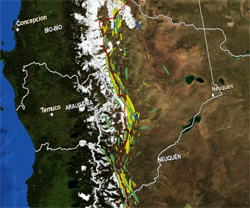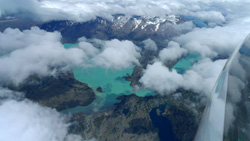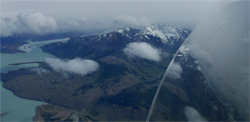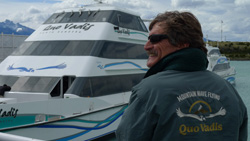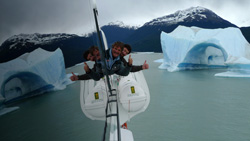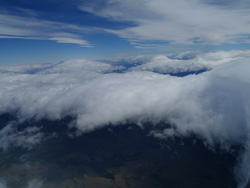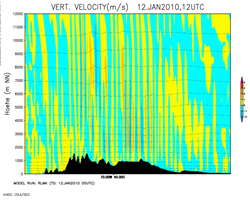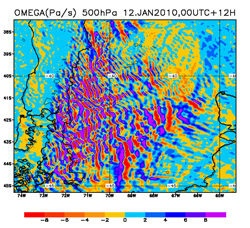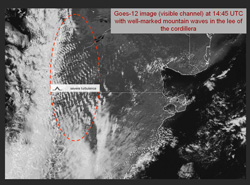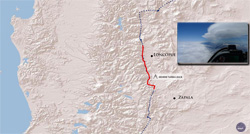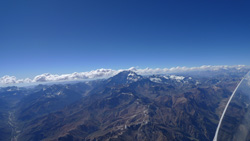

A true challenge for the soaring world - the new 2.500km OSTIV Kuettner -Prize
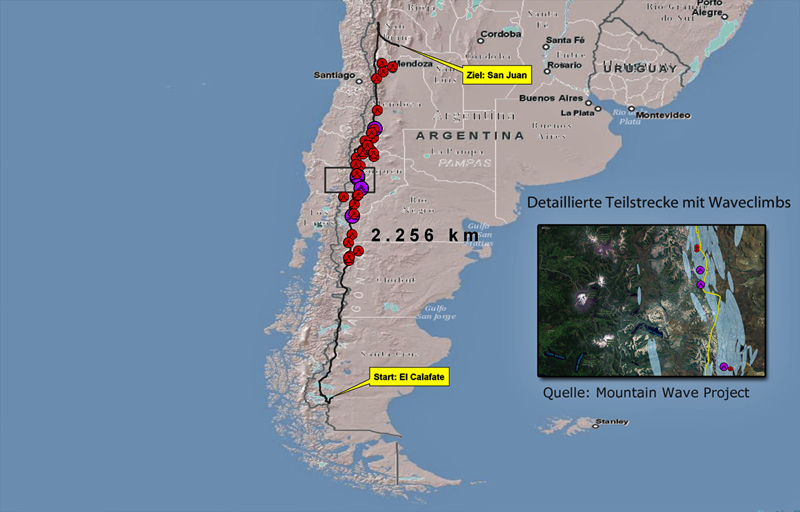
At least one week before the record something was going on. In 200 hPa it seemed, that the polar jetstream in the far south of Patagonia was going to melt together with his northern brother , the subtropical jet. A situation, very similar to the weather in 2003, where I could achieve the first 2.000 km flight in a straight ahead, well known as the 2.000km Kuettner Prize (UCAR-Magazine; Wikipedia Joachim Kuettner).
copyright: DLR/IPA, world record flight 23/11/2003 ECMWF-Analysis Windspeed and Geopotential at 250hPa
The same attitude of the polarjet with a SW tendency, promising strong tailwinds for the first part of the flight. But hold on, at first we have to arrive at El Calafate, some 1.150 km far from our base camp Chapelco, the airport of San Martin de los Andes. The closer the day comes, the denser the intensive look at weather charts, the more changes between hope and “fear” happens. What looked from far quite good, is developing to a real jetstream. In 3.000 m in the strongest part the forecast shows up to 75 kt , in 5.500 m even 90 kt. The experience is, that with these strong winds usually you have a lot of humidity. The day to go to Calafate looked as well quite difficult. Only with an early start it would be possible to arrive before an incoming coldfront. With the two stroke engine of our Nimbus it’s useless to expect to arrive with the motor at our destination. Usual strength of wind is more than 25 kt even in lower levels and the two hour fuel limit with speeds of 100 km/h gives a very reduced range, all that in an extreme hostile environment.
The last evening arrives and there are still a lot of doubts, but the only way to know how it will be, is to do it. The good thing is, that we will not loose another potential record. Nothing to regret.
So, a last look at the wave climb map to memorize the usual lift zones. These maps were realised in mwp co-operation with Prof. Alfred Ultsch at the University of Marburg and they are a precious help to remember the climbs of former flights.
The MWP-Wave forecast looks good. Robert Fessler, a good friend and passionated wave pilot wrote an additional tool years ago, and Prof. Thomas Prenosil from the Geo Information Service of Bundeswehr adapted it to the general mwp-waveforecast. Together with excellent wind and humidity-forecasts these maps were important tools for the progress of understanding the complex meteorology of the Andes. There is no doubt that without the continuous work of MWP-manager Rene Heise this progress would not have been possible.
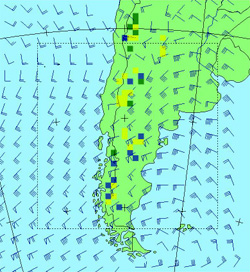 12 UTC RLM-FCST: strong (blue), moderate (green) and light (yellow) leewaves; Wind FL100
12 UTC RLM-FCST: strong (blue), moderate (green) and light (yellow) leewaves; Wind FL100
copyright: generalized MWP-wave and windforecast (FL100) with the relocatable local model (RLM) of BGIO
So, the glider is prepared for our long trip. Fuel and Oxygenbottles are full. We will use our high altitude security bottles with the EDS-System for the flight to the south in order to have the big bottles full for the long trip from Calafate to the airfield of Tinogasta. Some extra clothes have to be on board. We will be at least 4 days away from home. Last evening, weather is still between hope and fear. Spagetti and tomato sauce at home, the usual meal before a record day.
On the 10th of January the adventure starts...
It’s quite dry, but “little Chapelco” only 9 km from the airfield gives a good wave, as if he knows that we prefer to have full tanks for the south. Smoothly we are on the way. How funny, no hurry, we have only 1.150 km to fly. If it works, we will arrive in the afternoon at Calafate.
Only some small rotor puffs show us the way, weak lifts, but no strong sinks. From Esquel on the cloud cover increases not the climbspeeds. But lifts are very regular and well marked. Soon we can contact Puerto Mont to cross the terminal of Balmaceda. Surprise, no radar contact, even if our Mode S Transponder seems to work. But finally they trust our position reports and even make the coordination with Comodore Control, as we have no radio contact. The deep blue of Lago Buenos Aires has a mix up of wonderful colours on his border due to affluent rivers arriving from the glaciers. South of this big lake the landscape starts to be real wild. Cloud covering is growing as well seriously. In this area you have to know where you are, even with a small hole in the cloud mass. One of these holes gives us a breathtaking view on the green waters of Lago Belgrano.
Meanwhile we have radio contact with Comodore Control. Time to ask weather condition in Calafate. I’m very happy to hear a CAVOK, because around us it looks not at all like that. High Lenti champignons all around, the front of the forecast seems to be very close. Some rain or snow showers try to cut our way between the Lennies and them. Finally we can see the green of Lago San Martin and then even the Viedma glacier.
Fitzroy is hidden by the rain showers, as well the mighty icefield west of it, the Campo de Hielo. We use our early arrival to make a scenic flight along the national parc of the glacier area. The controller of Calafate reminds us to stay above FL 120, overflight below is prohibited. I try to catch a view from famous Perito Moreno glacier, but cloud cover is too important. Calafate gives the information, no jet traffic for the next hour, time to land. We use the motor and Wendelin as the wingman to reach our parking. A big pylon and some heavy stones serves as solid ancre to fix the glider on the ground. A gentle girl in ATC controls our papers and we prepare our departure for the 12th at 5:07 local time, 40 minutes before sunrise. The 50th latitude makes it possible. Now we can start our touristic plans for the rest day in Calafate.
We organise a full day glacier trip with one of these big tourist ships on the Lago Argentino. A great day and a real surprise. The name of the big Catamaran is Quo Vadis, same as my gliding school.
Even the Condor Symbol is there, incredible… So, easy to find contact with the captain and the crew members. A part of our journey we spend in the comfortable “Captains loft” and the “comandante” makes some very spectacular pictures with us.
An early dinner and some food organisation for the big flight, time to go to bed….
Record attempt - 12/01/2010 wake up call at 03:00 am...
taxi at 3:30, we arrive at 4:00 at the airport. The policeman knows about these strange pilots and soon we are on the apron to liberate our big bird from his pylon.
We push the glider along the taxiway to the runway. Only a smooth westerly wind, we are in the middle of the runway, but still 1300 m in front of us. At 5:18 the Solo motor wakes up its sixty horses and here we go. It looks like a winter day in Europe. Fresh fallen snow in the hills south of the field. We are in the middle of the Patagonian summer…Calafate is still dreaming..
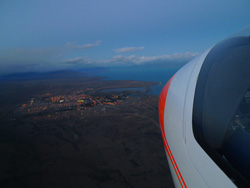
In the grey light I can see some unstable rolling rotors near our departure point south of the airfield. At 2000 m I stop the motor in some irregular lifts. The rotors are unstable, I always have to chase new puffs in front of our glider. A snow shower from the west seems to close the area near my departure point. We are just on top of the clouds, but I’m worried to stay in VMC. Luckily the shower is just a temporary event and one hour after start I pass trough the gate at 3.200 m. Our task is a declared 2.500 km straight distance to a goal flight and of course a trial to achieve once again the famous Küttner trophy, but this time there are 500 km more to travel. A nice low lenti above the Lago Argentina deceives with very poor lift. So I try to go against the wind to find the first wave of the mountains NW of the mighty lake. After a nearly endless fight with rolling rotors suddenly wave is there..2 ½ hours and 60 km flown, what an average…In 4.000 m we go. Now the strong wind in the altitude, which certainly created this terrible shear zone, is a mighty friend…But even the lifts are very strong, I only need to fly slowly in sometimes more than 4 m/s. Very strong winds are often together with weak lifts, but not today.. The more we go to the north, we are approaching the heart of the Jetstream. Our groundspeed vary between 250 and 420 km/h.. In no time all the wonderful lakes we admired two days ago are passing below our wings. How lucky we were about all the fotos and videos done on the trip down to the south. But how lucky as well to fly in a Jetstream and going so fast in a glider. Balmaceda north of the Lago Buenos Aires and Esquel seems to be very close. But now I’m a little bit afraid about the steadily increasing humidity, I expected from the forecast.
The foehn gaps are getting smaller and I try to fly as close as I can near FL 195 inorder to get not lost between these gigantic cloud masses. But luck is still on our side and the tops allows us always just to jump from lift to lift, no time lost. In Esquel we follow the usual alignements to Bariloche and soon our homebase Chapelco comes in sight. It’s 12:30, the last 1100 km were flown in 4 hours and forty minutes, whow…
copyright: RLMK-forecast 12 UTC (BGIO)
We have still a good tailwind component and a very nice Lenticularis in the Loncopue Valley is promising paradise. But now our luck is turning. The border of the much higher lenti gives which I pass trough, probably an error. The big rotor alignement below should work perfectly. Arriving high above the clouds I expect a laminar climbing. But instead of a smooth updraft we are received with a terrific turbulent and boiling air. Trying to circle I mesure a wind from 150°, absolutely crazy. I try to get the wave more to the west, but the glider falls like a stone, no chance to get the lift of this Lenti in this altitude.
copyright: RLMK-forecast 12 UTC (BGIO)
So I decide to follow the bumpy street to the north, circling from time to time in very rough lifts. At the end of the rotorline I find a good climb to nearly 6000 m and… back to the laminar flow, ouff…
I follow the last lenti to the north, blue sky and some Cu near the chilenien border. Looks not really like a record day. Don’t give up, the forecast told me about the weakness between the both jets. I cross the Cordillera del Viento and soon my optimism is back. Usual place usual wave, even in the blue sky. 6000 m, a lenti is forming in the Rio Grande Valley. After the strong downdraft a very nice wave receives us far in front of the Lenticularis cloud. We are now in the influence of the subtropical jetstream, much weaker, but still a wave creator. Time to call Malargue who makes the airspace coordination with Mendoza Control. “request FL 230”,,Approved..”
It looks good now to the north. Small rotors show us the way. In the north of Malargue the controller asks us if we are IFR equipped and have IFR Qualification. Euhh…. Yesterday I called Lito Fentanes, the president of the argentinian Aeroclub, who told me about a positive conference with the new bosses of the “Transito Aereo” for higher clearances. The short information seems to be enough and I change frequency to deal directly with Mendoza.
The controller allows me to continue with my comfortable altitude, but only with a position report every ten minutes. Loss of contact will be automatically FL 195. I made my best to stay high and to give always my report in time in order to gain another ten minutes in this comfortable altitude. Laguna Diamante 4 m/s, San José 5 m/s, I cannot resist.. “OH, request FL 250” , “Approved”, whow .. With 7500 m it’s much easier to turn around a small congestus above the 6800 m Volcano Tupungato. Now we can see the Aconcagua, the roof of America in front of us in a blue sky, some Cu are above the Cordillera de Tigre.
East of the mountains is nothing to see than a big brown wall made of dust. What the hell is that?..
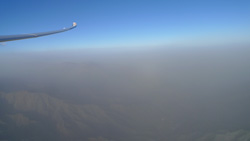
I continue, but now Mendoza radio contact is lost. I ask a 737 from LAN Chile to transmit my position and my gentle controller accept the new form of communication via commercial airplanes. Good luck once again, a lot of planes in the air…The Cu over the C. de Tigre, a deception. We continue to the north, into the high valley of Barreal. A huge range of mountains in the west, all around 6000 m high, spends us a new dry wavelift, once again we climb to FL 250. A nice surf with a continuous climbs allows us to progress with 200 km/h.
6:30 pm., we changed frequency to San Juan. I ask the last light in Catamarca.
Five to 09:00 pm local time
Still 430 km to our destination, still possible to go. But in front and below of us we have now the brown wall of dust with very bad visibility. I hope to find wave but even very close in the lee no lift no downdraft. I continue to make at least a free distance record. In 5000 m close to this brown nightmare I decide to go back to the south. To get my goal I have to pass over a range of up to 6000 m and land with the last light in an unknown airfield. Nobody knows the visibility. If I arrive, I’m the hero, if I fail, we are dead. Easy to make my choice. There will be a better day. I inform San Juan about our intentions to land there and ask for weather conditions. Smooth southern wind, visibility 8 km… Once we enter in the brown wall towards SanJuan, I feel happy for my decision. The only way to navigate is to look vertical below. No way to see something in front. I take out the airbrakes to go closer to the rocks to have some better visual reference. The two times I landed in San Juan helps a lot to recognise this big valley with a first and then a second lake. Once we are out of the mountains we can see the big city of San Juan. And fifteen minutes later we land on the nice runway of the aeroclub. What an adventure….
Klaus Ohlmann
Additional Infos:
Press Reports:
Last world records:
World Record up to declared 3 TP








